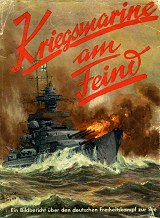BISMARCK ARMAMENT
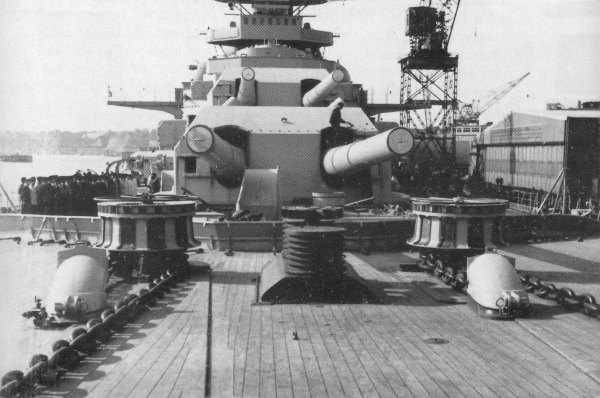 A view of the forward turrets "Anton" and "Bruno" from the forecastle. Summer of 1940.
A view of the forward turrets "Anton" and "Bruno" from the forecastle. Summer of 1940.
Updated 02 October 2020
Main Battery.
Eight 38 cm guns comprised Bismarck's main battery.
The principal purpose of these guns was to destroy surface targets at sea, although they could also be used for shore bombardment and, exceptionally, against aircraft.
Designed in 1934, the 38 cm SK C/34 were the most powerful guns ever mounted on a German warship.
These were housed in four armoured twin turrets alphabetically arranged from forward to stern.
Thus, turrets "Anton" and "Bruno" were located forward (frames 192.55 and 174.35), while turrets "Cäsar" and "Dora" were aft (frames 64.35 and 46.15).
Each turret weighed 1,056 metric tons, and was supported on a roller track platform.
Below there were a series of levels that extended from the upper deck down to the bottom of the ship.
The turrets were especially big compared with 38 cm twin turrets of other foreign warships, and the barrels were very separated from each other, therefore reducing interferences between them.
Each gun barrel could fire and be elevated independently of the other.
A special characteristic of these guns was their high muzzle velocity and low shell trajectories with a short flight time, which permitted to obtain a very accurate and rapid fire.
This was fully demonstrated in the morning of 24 May 1941 during the naval engagement with the British battlecruiser Hood.
The ammunition supply comprised 1,004 projectiles categorised into three different types:
38cm Psgr. L/4,4 (m.Hb), Panzersprenggranate L/4,4 (mit Haube).
These were Armour Piercing (AP) shells, base fused with windshield (mit Haube), and were painted in blue colour.
The task of the armour piercing shells was to penetrate armoured plates of heavily protected targets such as battleships and detonate in the interior causing severe destruction to vital parts (boilers, magazines, etc).
If used against light or unarmoured targets/surfaces, AP shells would simply penetrate these and pass through exploding beyond the target or without even detonating due to the insufficient resistance to activate the fuse.
A total of 93 projectiles of this type were fired at Hood and Prince of Wales during the battle of the Denmark Strait on 24 May 1941.
38cm Spgr. L/4,5 Bdz (m.Hb), Sprenggranate L/4,5 Bodenzünder (mit Haube).
These were High Explosive (HE) shells, base fused (Bodenzünder) with windshield, and were painted in yellow colour.
The penetrating capabilities of the high explosive shells with base detonating fuse were inferior than those of AP shells, however the effects of the detonation were greater since HE shells contained a larger explosive charge.
This type of projectiles was utilized against relatively lightly armoured targets such as cruisers.
38cm Spgr. L/4,6 Kz (m.Hb), Sprenggranate L/4,6 Kopfzünder (mit Haube).
These were High Explosive (HE) shells, nose fused (Kopfzünder) with windshield, and were painted in yellow colour with a black arrow pointing at the nose to differentiate them from base fused shells.
The principal effect of high explosive shells with nose detonating fuse was the action of splinters due to their large explosive charge.
Nose fused projectiles had very limited penetrating capabilities and were intended to be used against soft targets such as destroyers or merchantmen.
| Designation |
Type |
Weight |
Explosive
charge |
Cap weight
(without windshield) |
Length |
Fuse |
Delay |
| Psgr. L/4,4 (m.Hb) |
AP base fused |
800 kg |
18.8 kg |
112.50 kg |
1.672 m |
Bdz 38 |
0.0035 sec. |
| Spgr. L/4,5 Bdz (m.Hb) |
HE base fused |
800 kg |
32.6 kg |
69.35 kg |
1.710 m |
Bdz 38 |
0.0035 sec. |
| Spgr. L/4,6 Kz (m.Hb) |
HE nose fused |
800 kg |
64.25 kg |
- |
1.748 m |
Kz 27 |
none |
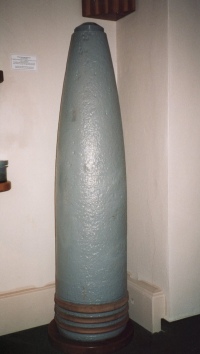 |
Left: A 38 cm Spgr. L/4,6 Kz projectile on display at the Wrackmuseum in Cuxhaven. Its nose has been removed. These projectiles were 1.7 m high and weighed 800 kg. Photo courtesy of Maurice Laarman.
 |
CHARACTERISTICS
| Designation: |
38 cm SK C/34 |
| Number: |
8 (2 x 4) in four twin turrets two forward, two aft |
| Barrel length (L/52): |
19.630 meters |
| Bore length (L/48.5): |
18.405 meters |
| Barrel weight: |
110.7 metric tons |
Barrel rifling:
· Groove depth:
· Groove width: |
90 grooves, right handed twist.
4.50 mm
7.76 mm |
Turret weight (without barbette):
· Anton:
· Bruno:
· Cäsar:
· Dora: |
1,048 metric tons (without 10.5-m rangefinder)
1,056 metric tons
1,056 metric tons
1,056 metric tons
|
| Elevation range: |
between -5.5° and +30° |
Training range:
· Turrets Anton and Bruno:
· Turrets Cäsar and Dora: |
215º - 0º - 145º
035º - 180º - 325º |
| Training rate: |
5.4°/second |
| Elevation rate: |
6°/second |
| Rate of fire: |
2.4+ rounds/minute/barrel |
| Maximum range: |
35,550 meters at 30° = 38,880 yards at 30° |
| Muzzle velocity: |
820 meters/second = 2,690 feet/second |
| Shell weight: |
800 kg = 1,764 lbs |
Propellant charge weight:
· Fore cartridge (Vorkartusche):
· Main cartridge (Hauptkartusche): |
99.5 kg = 219.3 lbs
112 kg = 246.9 lbs |
Ammunition supply:
· 38cm Psgr. L/4,4 (m.Hb):
· 38cm Spgr. L/4,5 Bdz (m.Hb):
· 38cm Spgr. L/4,6 Kz (m.Hb):
Total: |
353 base fused AP shells
338 base fused HE shells
313 nose fused HE shells
1,004 |
| Barrel life: |
200-300 rounds |
| Loading angle: |
2.5° |
Click here to see the range and penetration table for the 38 cm SK C/34.
Secondary Battery.
The ammunition supply comprised 1,288 projectiles categorised into two different types:
15cm Spgr. L/4,5 Bdz (m.Hb), Sprenggranate L/4,5 Bodenzünder (mit haube). High Explosive (HE) shells, base fused (Bodenzünder) with windshield (mit haube).
15cm Spgr. L/4,6 Kz (m.Hb), Sprenggranate L/4,6 Kopfzünder (mit haube). High Explosive (HE) shells, nose fused (Kopfzünder) with windshield (mit haube).

| Designation: |
15 cm SK C/28 |
| Number: |
12 (2 x 6) 3 twin turrets by side |
| Barrel length (L/55): |
8.25 meters |
| Barrel weight: |
9.08 metric tons |
Barrel grooves:
· Depth:
· Width: |
44
1.75 mm
6.14 mm |
| Turret weight (without barbette): |
108 metric tons
110 metric tons (central) |
| Elevation range: |
between -10° and +40° |
| Training rate: |
8°/second |
| Elevation rate: |
9°/second |
| Rate of fire: |
8 rounds/minute/barrel |
| Maximum range: |
23,000 meters at 40° = 25,150 yards at 40° |
| Muzzle velocity: |
875 meters/second = 2,871 feet/second |
| Shell weight: |
45.3 kg = 99.8 lbs |
| Propellant charge weight: |
23.5 kg = 51.8 lbs |
Ammunition supply:
· 15cm Pzgr. L/3,7 Bdz (m.Hb):
· 15cm Spgr. L/4,5 Bdz (m.Hb):
· 15cm Spgr. L/4,6 Kz (m.Hb):
· 15 cm Lg. L/4,6: |
- base fused AP shells
622 base fused HE shells
666 nose fused HE shells
240 starshells (Leuchtgranate) |
| Barrel life: |
2,500 rounds |
Heavy Anti-aircraft Battery.

| Designation: |
10.5 cm SK C/33 |
| Number: |
16 (2 x 8) in 4 double mounts by side |
| Barrel length (L/65): |
6.825 meters |
| Barrel weight: |
4.56 metric tons |
| Mount weight: |
Mounting C31: 27.350 metric tons
Mounting C37: 26.425 metric tons |
| Elevation range: |
Mounting C31: between -8° and +80°
Mounting C37: between -10° and +80° |
| Angular velocity: |
Mounting C31: vertical: 10°/sec, horizontal: 8°/sec
Mounting C37: vertical: 12°/sec, horizontal: 8.5°/sec |
| Rate of fire: |
18 rounds/minute/barrel |
| Maximum range: |
17,850 meters = 19,521 yards |
| Vertical range: |
13,000 meters = 14,217 yards at 80º |
| Muzzle velocity: |
900 meters/second = 2,952 feet/second |
| Shell weight: |
15.1 kg = 33.1 lbs |
Ammunition supply:
· 10,5 cm Spgr. L/4,4:
· 10,5 cm Lg. L/4: |
6,825 shells
337 starshells (Leuchtgranate) |
Medium Anti-aircraft Battery.

| Designation: |
3.7 cm SK C/30 |
| Number: |
16 (2 x 8) in 4 double mounts by side |
| Barrel length (L/83): |
3.071 m |
| Elevation range: |
between -10º and +80º |
| Rate of fire: |
80 rounds/minute/barrel (about 30-40 in practice) |
| Maximum range: |
6,750 meters = 7,382 yards |
| Muzzle velocity: |
1,000 meters/second = 3,281 feet/second |
| Shell weight: |
0.745 kg = 1.64 lbs |
| Ammunition supply: |
34,100 projectiles |
Light Anti-aircraft Battery.
| Designation: |
2 cm MG C/30 |
| Number: |
10 in single pedestals (Sockel-Lafette)
2 in single mounts |
| Barrel length (L/65): |
1.3 meters |
| Elevation range: |
between -10º and 85º |
| Rate of fire: |
200 rounds/minute |
| Maximum range: |
4,600 meters = 5,030 yards |
| Vertical range: |
3,500 meters at 85º |
| Muzzle velocity: |
875 meters/second = 2,870 feet/second |
| Shell Weight: |
0.132 kg = 0.291 lbs |
| Ammunition supply: |
22,000 projectiles |
| Designation: |
2 cm Flak C/38 |
| Number: |
8 in 2 quadruple mounts1) |
| Barrel length (L/65): |
1.3 meters |
| Elevation range: |
between -10º and +100º |
| Rate of fire: |
200 rounds/minute/barrel |
| Maximum range: |
4,600 meters = 5,030 yards |
| Vertical range: |
3,500 meters at 85º |
| Muzzle velocity: |
875 meters/second = 2,870 feet/second |
| Shell Weight: |
0.132 kg = 0.291 lbs |
| Ammunition supply: |
22,000 projectiles |
1) The quadruple 2 cm Flak C/38 mounts situated on both sides of the foremast above the searchlight platform were installed in Gotenhafen in late April 1941.
* To get the length of a barrel we have to multiply the thickness of the barrel by its length in caliber lengths.
Therefore, a 38cm/L52 rifle would be 38 cm x 52 = 1,976 cm.

Copyright © 1998-2024 KBismarck.com

 UPDATES
UPDATES
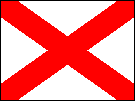
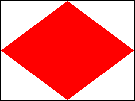
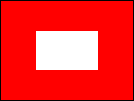
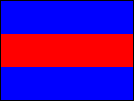


![]()
![]()
![]()


